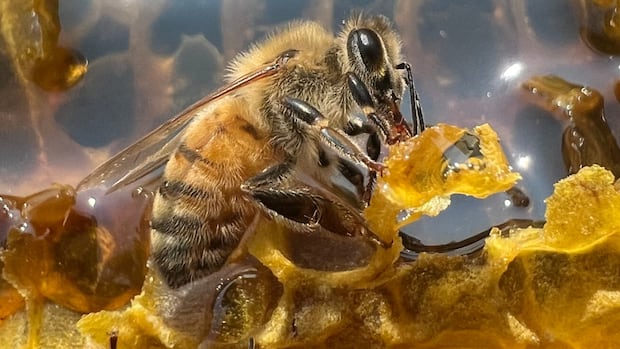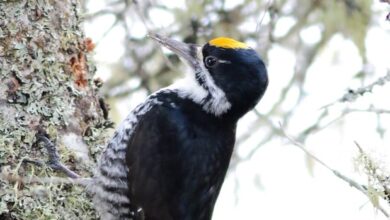It’s a small world: Winners of microscopic video competition reveal the tiny in stunning detail
;Resize=(620))
It’s not every day we get to see the tiny world that exists beyond our vision, but that’s what the Nikon Small World in Motion competition is all about.
This is the 14th year of the competition, where past winners revealed extraordinary insights into things like the stomach contents of a termite, human cells fusing and dying during a COVID-19 infection and dying melanoma cells. The videos do not have to be taken with a Nikon product.
This year, the competition drew more than 300 videos from roughly 40 countries.
This year’s winners seemed to have upped the ante for the competition. Here are the top five.
5th place: A baby tardigrade riding a nematode
In this fifth-place video, Quinten Geldhof from Winthrop, Mass., captured a tardigrade riding the back of a nematode, a type of microscopic worm.
A baby tardigrade riding a nematode.
Tardigrades, sometimes referred to as “water bears,” are incredible organisms.
They measure roughly one millimetre in length and have four pairs of legs, each of which contain four to eight pairs of claws. They can be found around the world in almost any type of environment. In fact, they are considered to be one of the most resilient species around, surviving without oxygen, water, in boiling alcohol, low pressure, high pressure and many more environments. They’ve even survived the harsh radiation of space.
Under dry conditions, they will curl up into a ball called a tun, with their metabolism slowing to less than 0.01 per cent of normal.
Interestingly, nematodes and tardigrades have been known to eat one another. It’s unclear who had the advantage in this micro rodeo.
4th place: Friction transition in a microtubule-based active liquid crystal (say what?)
That title is a bit of a head-scratcher to anyone who’s not a biologist.
Microtubules are major components of the cytoskeleton, a system of filaments or fibres that make up eukaryotic cells, which are found in animals, fungus, plants and protists (single-celled organisms).
Ignasi Vélez Ceron, Francesc Sagués and Jordi Ignés-Mullo from the University of Barcelona captured this video, which shows these microtubules moved by something called kinesin motors. These motors essentially help tell proteins where to go in cells. Because the material has both order and activity, it is considered an active liquid crystal, hence the name of this video.
Friction transition in a microtubule-based active liquid crystal.
The movement almost seems artistic, but what we’re seeing is the change in textures produced by friction within the system. Because of this friction, the material is constricted, and we watch as the microtubules adapt and reorganize.
3rd place: An oligodendrocyte precursor cell in the spinal cord of a zebrafish
Let’s be honest: “oligodendrocyte precursor” is a mouthful, and also … what the heck is it?
Canadian Samantha Yammine, also known as Science Sam, is a trained biologist, neuroscientist and science communicator. She also served as one of the six judges in the competition.
An oligodendrocyte precursor cell in the spinal cord of a zebrafish.
That mouthful is a type of cell, she explains.
“Essentially, if you think of the nerves in our bodies, they’re kind of like wires. And then if you look at your charger for your laptop, or even the wire on your headphones, it’s surrounded in rubber to protect the wires,” she said. “Our nerves also have that. They’re surrounded with a fatty substance called an oligodendrocyte, and that just helps the nerves to conduct signals more efficiently.”
Dr. Jiaxing Li from Portland, Ore., captured this at 20x magnification in the spinal cord of a zebrafish.
2nd place: Water droplets evaporating from the wing scales of a peacock butterfly
Admittedly, this looks like an AI-generated video. But it’s not.
Second-place winner Jay McClellan of Saranac, Mich., has made many of these videos before using an extensive set-up. He’s also taken microscopic videos of other butterflies.
Water droplets evaporating from the wing scales of a peacock butterfly (Aglais io).
McClellan has been fascinated with the microscopic since he was a boy. The retired electrical engineer and software developer uses his skills to turn what he sees under a microscope into art.
In order to capture the amazing process of evaporation, he mounted the wing of a specimen on an aluminum card so that he could hold it down and move it around.
“It’s about 300 individual images for each finished frame of the final video,” McClellan told CBC News. “So each frame that you see is actually … a stack of 300 raw images, each with a tiny sliver in focus.”
Over the years he’s collected a lot of data engaging in this amazing hobby.
“Some of my videos that I’ve made use many terabytes of raw footage,” he said. “I have a server with 128 terabytes of hard disk space, and it’s full.”
1st place: Mitotic waves in the embryo of a fruit fly
In this video by Bruno Vellutini from the Max Planck Institute of Molecular Cell Biology and Genetics in Dresden, Germany, we see mitosis, or cell division, taking place in a fruit fly embryo.
“All the little dots, those are different cells, and you’re getting divisions of the genetic material so that you can make lots of copies and build the entire blueprint of the embryo,” Yammine said.
“In fruit flies, you’re having them going all at once, which is why it’s so cool. They’re completely synchronous. So you can see all of them are like, boom, boom, boom. And that’s happening about every eight minutes, which is really fast, and why this is such an exciting organism to study.”
Mitotic waves in the embryo of a fruit fly (Drosophila melanogaster).
Vellutini is a zoologist with a background in evolutionary and developmental biology, whose research aims at better understanding how embryos develop from a single cell. What he’s captured in his video is also linked to processes that can go wrong, which can lead to the development of cancer and other diseases, mainly if the process is disrupted.
“Fruit fly embryos are in our homes, developing in our kitchens and our trash bins … undergoing the same processes as shown in the video,” he said in a statement. “I believe the video is particularly impactful because it shows us how these fascinating cellular and tissue dynamics are happening every day, all around us — even in the most mundane living beings.”
Yammine said this competition is a perfect merger of art and science.
“Art and science are inseparable. They go hand in hand,” she said. “It’s through science and art where you are inspired to stop and pause and think about how even the smallest thing around you that you’re not even noticing is filled with things to be curious and awed [about].”
You can find the winners and honourable mentions online at Nikon’s Small World in Motion Competition.








